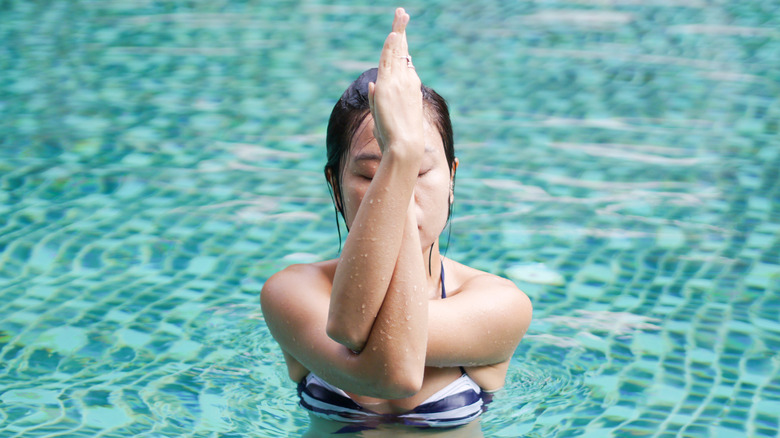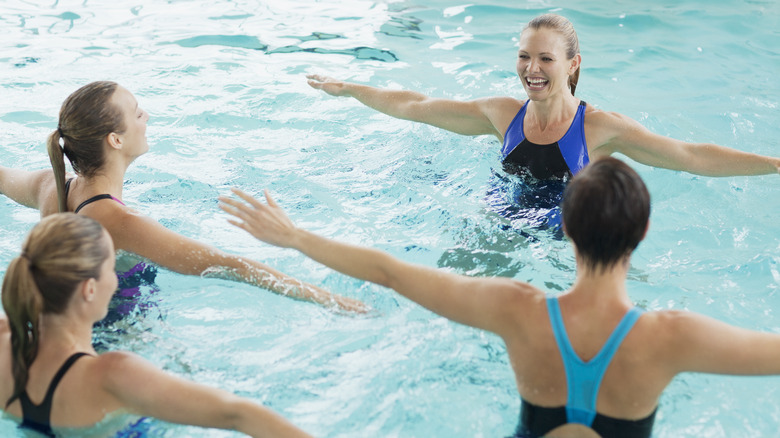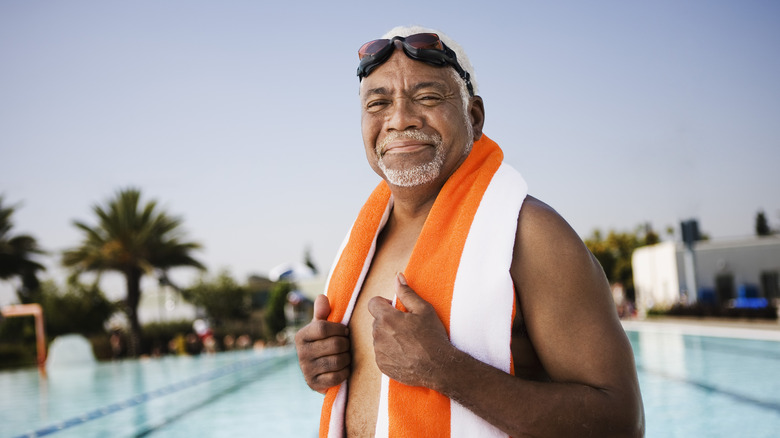Why Aqua Yoga Is The Perfect Exercise For Reducing Joint Pain
If you've ever had an exercise-related injury, you know how joint pain can make you wince at the thought of exercising. Arthritis sufferers know joint pain well, but people with anxiety, depression, and stress might also experience it (via Cleveland Clinic). A nice soak in the tub or popping an anti-inflammatory might help, but physical activity can also help to loosen the joints to ease the pain. According to the Mayo Clinic, you should include exercises that improve strength and range of motion while moderately raising your heart rate. But this doesn't mean you have to run a 5K. Instead, you can try aqua yoga.
According to Yoga Jala, aqua yoga is about doing yoga poses, breathwork, or meditation while in the water. Because you're more buoyant in the water, aqua yoga cuts down on some of the force on your joints. That's why aqua yoga is perfect for people with osteoarthritis, obesity, bone density problems, or mobility issues. Fitness beginners, older adults, and those who are pregnant can also benefit from this low-impact yoga.
What to expect from an aqua yoga class
Depending on the class, you'll most likely do aqua yoga in a pool's shallow end, where you'll be at least 50% covered by water (via Yoga Jala). This allows you to have your feet firmly planted on the bottom surface of the pool. Some of the poses will be done with your head out of the water, and others might ask you to hold your breath as your head goes under.
If you've taken a land-based yoga class, some of the poses will look the same (via Yoga Jala). You'll probably stick to beginner poses like mountain, tree, and chair. Bow pose, where your belly is typically on the mat while you hold your ankles, will look different in an aqua yoga class. An aqua yoga bow pose might be inverted, where your belly and face are on the water's surface. Poses like savasana, or corpse pose, won't have you lying down underneath the water. Instead, you'll take some pool noodles and float on the surface.
However, you'll need to check the class description, especially if you have joint pain. Some aqua yoga classes are done on a floating yoga mat in a pool (via Prevention). This will be more similar to a SUP yoga class, which might not be best for people with joint pain.
The benefits of water-based exercise
Aqua yoga can help with flexibility, balance, and stress (via Yoga Jala). The water will also provide a nice resistance so you can improve your strength and posture while reducing the pressure on your joints.
If you don't have aqua yoga classes near you but have access to a pool, you can still reap the benefits of water-based therapy. A 2008 study in Physical Therapy studied the effects of water-based and land-based exercises on osteoarthritis of the knee. Although both methods were effective, the water-based exercise was better at relieving pain before and after a walking test.
The University of Washington Medicine states it's important to exercise your joints even though you might not want to move. Without exercise, the muscles and joints will weaken and lose their range of motion, leaving you stiffer and with more pain. Soaking your body in warm water helps relax your muscles enough to exercise. The buoyancy and resistance of the water will allow you to exercise safely. Just be sure the water isn't too hot. Water temperatures between 83 to 88 degrees Fahrenheit are optimal for water-based exercises.



